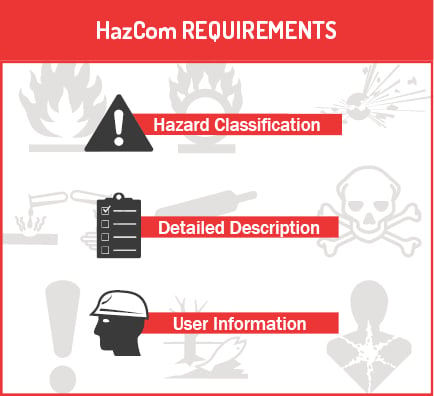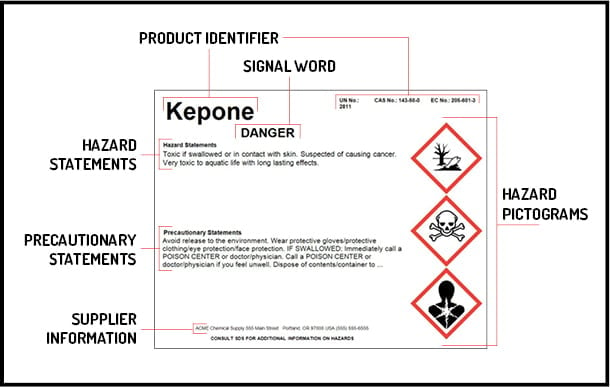HazCom
03
February,
2023
4 MINUTE READ

What is HazCom?
"HazCom" is short for "Hazard Communication," which works to keep people safe by providing information about potential sources of injury - specifically, hazardous chemicals in the workplace.
OSHA's Hazard Communication Standard (HCS) is the set of regulations covering chemical labels in the workplace. These rules were updated in 2012 to generally align with an international standard called the Globally Harmonized System (GHS). Because this update was published in 2012, many people refer to the current set of rules as "HazCom 2012."
Before the 2012 update, these rules were often called "Right-To-Know" or "RTK," because they were focused on a worker's right to know about the hazards that they could be exposed to in the workplace. The update incorporated a clear and consistent way to talk about different kinds of hazards, with an emphasis on ensuring that workers could actually understand the information they were given. Because of the change, chemical safety systems that complied with the old RTK rules may not meet the requirements of the current rules in HazCom 2012.
OSHA HazCom Rules in 29 CFR 1910.1200
All of OSHA's regulations are in Title 29 of the Code of Federal Regulations, or 29 CFR. The HazCom rules apply to what OSHA calls "general industry," or most workplaces in the United States, so they're in Part 1910 of that massive collection of rules. Finally, the HazCom section of the regulations is section 1200. Put together, this means the actual text of HazCom 2012 can be found in 29 CFR 1910.1200.
Because the GHS standard is published by the United Nations for use around the world, OSHA had to make some changes to the standard in order to make it fit United States law. For example, some of the issues that GHS addresses, like environmental hazards, are outside OSHA's jurisdiction. At the same time, some of the hazards that OSHA is concerned about, such as combustible dusts and simple asphyxiants, simply weren't covered under the broader GHS standard. As a result, the GHS and HazCom 2012 systems are similar, but not identical.
HazCom Requirements
 The core of both GHS and HazCom 2012 is a series of three required steps:
The core of both GHS and HazCom 2012 is a series of three required steps:
- Hazard Classification through standardized and documented laboratory tests
- Detailed Description through a standardized Safety Data Sheet (SDS)
- User Information through standardized container labels
The first step, classifying the hazards of a chemical, relies on the results of specific tests to identify the type and severity of each potential hazard. Different types of hazards are identified by Hazard Classes, while different levels of severity are identified with Categories. Hazard Classes are given clear names, such as "Flammable Liquid" or "Carcinogen." Within each Class, the Categories are numbered, with the most dangerous category called "Category 1" and less severe hazards counting up from there, such as "Category 2" and "Category 3," until the hazard is no longer serious.
The next step, describing the chemical in detail, involves writing down the results of that classification into a specially-organized document called a Safety Data Sheet (SDS). Under the RTK rules, a similar document called a Material Safety Data Sheet (MSDS) was required. However, these documents could take a variety of forms, and there was no guarantee that any two MSDSs would be organized in the same way. This problem is resolved with the new SDS format, which requires a specific 16-part sequence to describe all of the relevant details about a chemical.
The third step in the core of HazCom and GHS is to provide useful information for the actual users of the chemical, at the time and place they need that information. This is achieved with container labeling, and as a result, container labels are the most visible part of the HazCom system.
HazCom Labels
There are two major types of container labels under OSHA's HazCom 2012 rules: labels for shipping, and labels for workplace use.
Containers that will leave a facility need labels that closely adhere to a standardized format, minimizing the risk of confusion. For these "shipping labels," OSHA requires a format that uses the same six basic elements as an international GHS label:

- Product Identifier: the name of the material as it appears on the SDS, along with the identity of any ingredients that contribute to the material's health hazards
- Signal Word: "Danger," "Warning," or no signal word at all, to indicate the overall severity of the chemical's hazards
- Hazard Pictograms: eye-catching symbols surrounded by red diamond-shaped outlines, showing the general types of hazards posed by the material
- Hazard Statements: standardized and specific phrases describing the exact hazards of the material
- Precautionary Statements: instructions for workers to protect themselves and respond appropriately to accidental exposure
- Supplier Information: the name, address, and phone number of the material's supplier
By requiring every chemical supplier and distributor to add a standardized label to each container before shipping it, OSHA can stop the problem of missing or unclear information at the source. But once these chemicals enter a facility where they will be used and not shipped out again, the individual facility may have an approach to chemical safety that works more effectively there. This is why OSHA relaxes their requirements for workplace labels.
On workplace labels, facilities may choose to use the same standardized six-part labels that would be required for shipping, or they may use any other labeling system they like, as long as the chosen approach meets these three requirements:
- Each label needs to show the Product Identifier (the name of the material), to avoid any confusion.
- Labels need to give at least basic hazard information, and they need to give it in a form that workers will understand.
- All of the details about the material's hazards, including what workers need to do to be safe, must be immediately available to those workers. This doesn't mean the information needs to be on the label, but it does need to be provided in some reliable and accessible way.
In order to gain the benefit of HazCom's standardized approach, workers need to be trained to understand the HazCom system. Employers are required to provide this training, and Duralabel can help. Grab our Guide to the HazCom 2012 system, or attend a HazCom webinar discussing its requirements.
RELATED RESOURCES

Five Ways to Meet OSHA Requirements for Safety Signage
Every day, American workers service high-powered equipment, build and fix roads, and manufacture the goods we ...
Read
OSHA 1910 144 Color Identification
Standard Number: 1910.144 Safety color code for marking physical hazards. 1910.144(a) Color identification - ...
Read
Lean Facility
Creating a Lean Facility The global market places significant pressure on businesses and other organizations ...
Read.png)


